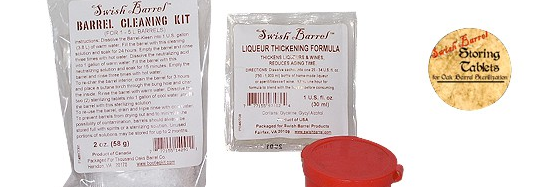Cleaning your Oak Barrel

How often do I clean my barrel?
When aging hard spirits such as whiskey, rum or tequila, clean the barrel after two or three batches (or every 1 to 2 years). For wine, cider, liquor or other low alcohol content spirits, clean after each batch.
How do I clean my barrel?
1) Dissolve the Barrel-Kleen into warm water. Fill the barrel with this cleaning solution and soak for 24 hours. Empty and rinse 3 times with hot water.
2) Dissolve the Neutralizing Acid into warm water. Fill the barrel with this neutralizing solution and soak for 15 minutes. Empty and rinse the barrel 3 times with hot water.
3) To re-char the barrel interior, drain the barrel for 3 hours. Place a butane torch in the bung and spigot hole and re-char the inside.
To prevent the barrel from drying out and minimize the possibility of contamination, barrels should always be stored full with spirits or water with sterilizing solution.
***See cleaning package directions for exact mixture quantities.
How do I store my barrel?
When storing the barrel fill the barrel with a mixture of sterilizing tablets and cool water. Fill the barrel with the solution and leave in a cool damp place until you are ready to use again.
Most Asked Oak Barrel Questions...

The hoops are loose or have fallen off... What do I do?
Our barrels are handmade without the use of any nails. As the wood dries the barrel shrinks and hoops loosen. Hooping is fitted in location but is only stabilized after the curing process when the barrel swells into place due to the expansion of the wood. Simply hand force the hoop into its proper location and slightly tap the banding’s side with a blunt item around the entire circumference of the barrel until tight. Then proceed to the curing process.
When I opened the box and pulled out the barrel, I hear something inside the barrel rattling...?
It is common for the barrel to have small pieces of wood inside. Your barrel is charred internally and can cause pieces from the inside to separate from the body. THIS IS GOOD NEWS! The more charred surface contact with the spirit, the faster it will age. Simply strain the spirit before drinking.
How do I insert my spigot?
Please be conscious that your spigot is the most delicate part of your new barrel. You will have to hand force the spigot into the hole as far as it will go. Turn the movable top piece to the side then tap in using a rubber mallet or hammer with a towel or shock absorbent material to prevent it from being “cracked”.On a side note please remember that once your spigot is in place to make sure it is at the proper angle, as once it is cured the spigot will swell as well and be permanently in that position
How do I cure my barrel?
All barrels need to swell to ensure proper function. Use boiling or hot water and fill your barrel to the top through the bung hole. When doing this, place in an area that allows for seepage coming through the wood (i.e. kitchen sink, outside, tub etc…) Although there may be no leaks immediately, the wood does need to swell internally for a period of time before use, a minimum of 3-5 days is preferred. Curing the wood will minimize the absorption of precious spirit into the body of the barrel.
DO NOT SUBMERGE YOUR BARREL IN WATER!!!
My barrel is taking on a blackish color:
This is referred to as “leaching”. All barrels can produce a discoloration during the curing process. As the water makes its way through the wood, it will push out coloration from anything in its way. This is perfectly normal and seen in all commercial barrels in the beer, wine and distilling world.
When I turn my spigot, nothing is coming out:
Physics 101…remove the bung when dispensing to release pressure and allow for airflow.
After many months, there’s little (or no) spirit:
Smaller barrels age 8-10 times faster than a full sized version. Therefore, the “angel’s share” (natural evaporation) is also increased. Due to its rapid aging process most spirits are at their optimum result within 1 to 3 months. Taste periodically and when accepted best to your pallet remove the contents into a bottle with appropriate aging notes and begin your next batch. If there are teenagers in your home, you may also want to investigate the “My Little Angels Share” option.
